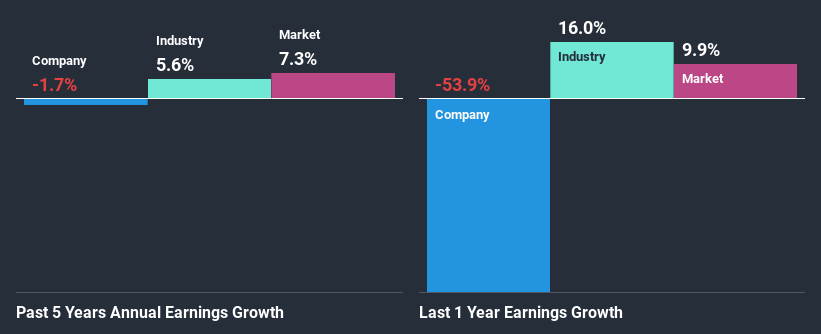Does Kathmandu Holdings Limited's (NZSE:KMD) Weak Fundamentals Mean That The Stock Could Move In The Opposite Direction?
Most readers would already know that Kathmandu Holdings' (NZSE:KMD) stock increased by 3.7% over the past three months. Given that the markets usually pay for the long-term financial health of a company, we wonder if the current momentum in the share price will keep up, given that the company's financials don't look very promising. Particularly, we will be paying attention to Kathmandu Holdings' ROE today.
Return on Equity or ROE is a test of how effectively a company is growing its value and managing investors’ money. Simply put, it is used to assess the profitability of a company in relation to its equity capital.
See our latest analysis for Kathmandu Holdings
How Do You Calculate Return On Equity?
The formula for return on equity is:
Return on Equity = Net Profit (from continuing operations) ÷ Shareholders' Equity
So, based on the above formula, the ROE for Kathmandu Holdings is:
3.0% = NZ$24m ÷ NZ$781m (Based on the trailing twelve months to January 2021).
The 'return' is the profit over the last twelve months. Another way to think of that is that for every NZ$1 worth of equity, the company was able to earn NZ$0.03 in profit.
Why Is ROE Important For Earnings Growth?
So far, we've learned that ROE is a measure of a company's profitability. Based on how much of its profits the company chooses to reinvest or "retain", we are then able to evaluate a company's future ability to generate profits. Assuming everything else remains unchanged, the higher the ROE and profit retention, the higher the growth rate of a company compared to companies that don't necessarily bear these characteristics.
A Side By Side comparison of Kathmandu Holdings' Earnings Growth And 3.0% ROE
It is quite clear that Kathmandu Holdings' ROE is rather low. Even when compared to the industry average of 14%, the ROE figure is pretty disappointing. Therefore, Kathmandu Holdings' flat earnings over the past five years can possibly be explained by the low ROE amongst other factors.
As a next step, we compared Kathmandu Holdings' net income growth with the industry and discovered that the industry saw an average growth of 5.6% in the same period.
The basis for attaching value to a company is, to a great extent, tied to its earnings growth. The investor should try to establish if the expected growth or decline in earnings, whichever the case may be, is priced in. Doing so will help them establish if the stock's future looks promising or ominous. Has the market priced in the future outlook for KMD? You can find out in our latest intrinsic value infographic research report.
Is Kathmandu Holdings Efficiently Re-investing Its Profits?
Kathmandu Holdings has a high three-year median payout ratio of 65% (or a retention ratio of 35%), meaning that the company is paying most of its profits as dividends to its shareholders. This does go some way in explaining why there's been no growth in its earnings.
Moreover, Kathmandu Holdings has been paying dividends for at least ten years or more suggesting that management must have perceived that the shareholders prefer dividends over earnings growth. Based on the latest analysts' estimates, we found that the company's future payout ratio over the next three years is expected to hold steady at 71%. Regardless, the future ROE for Kathmandu Holdings is predicted to rise to 11% despite there being not much change expected in its payout ratio.
Conclusion
In total, we would have a hard think before deciding on any investment action concerning Kathmandu Holdings. As a result of its low ROE and lack of mich reinvestment into the business, the company has seen a disappointing earnings growth rate. With that said, we studied the latest analyst forecasts and found that while the company has shrunk its earnings in the past, analysts expect its earnings to grow in the future. To know more about the company's future earnings growth forecasts take a look at this free report on analyst forecasts for the company to find out more.
This article by Simply Wall St is general in nature. It does not constitute a recommendation to buy or sell any stock, and does not take account of your objectives, or your financial situation. We aim to bring you long-term focused analysis driven by fundamental data. Note that our analysis may not factor in the latest price-sensitive company announcements or qualitative material. Simply Wall St has no position in any stocks mentioned.
Have feedback on this article? Concerned about the content? Get in touch with us directly. Alternatively, email editorial-team (at) simplywallst.com.

 Yahoo Finance
Yahoo Finance 
